(2: 贵州省喀斯特山地生态环境国家重点实验室培育基地, 贵阳 550001)
(2: State Key Laboratory Incubation Base for Karst Mountain Ecological Environment of Guizhou Province, Guiyang 550001, P.R.China)
磷(P)是生态系统中初级生产力的重要限制因素,是水华发生的重要驱动力[1-4]。根据来源划分,水库中的磷主要分为外源磷与内源磷[5]。在对外源磷的输入进行有效控制后,内源磷的释放成了维持湖泊初级生产和营养状态的重要营养源[6]。水库沉积物中的磷受到水环境、溶解氧(DO)、pH、氧化还原电位(Eh)、水动力、水温、生物扰动等影响时,一部分磷酸盐将不断向上覆水释放,成为水体磷污染的重要来源[7-8],从而加重水库的磷污染负荷,对水体的富营养化水平产生重要影响[9]。因此,深入理解水库沉积物磷的迁移转化特征及磷污染水平对制定水库的富营养化治理策略具有重要意义[10-12]。
中国西南岩溶区是世界三大岩溶区之一,由流水“二元侵蚀”结构[13]切割形成了大量的河流峡谷区,河网密布。为解决“田高水低”的水土资源空间不匹配困局,修建了大量的岩溶峡谷型水库,改变了原有营养物质(氮、磷等)的生物地球化学循环模式[14-15]。岩溶峡谷型水库具有“V”形河谷、河谷深切、河库狭窄、水体深度大、高溶解固体物、高钙和高碱度等特点[16]。岩溶峡谷型水库水体中高浓度的Ca2+和HCO3-在水生植物光合作用下会促进碳酸钙沉淀,同时生物碳泵产生的碳酸钙可促进水中磷的共沉淀,导致可溶性磷酸盐转化为不溶性磷酸盐,已有研究发现大于74%的磷酸根离子与碳酸盐一起沉淀[17-18]。岩溶峡谷型水库水域生态系统的生产、消费环境条件不同于平原地区的浅水水库,形成了独特的岩溶峡谷型水库水生生态系统的营养物质迁移、转化规律。虽然岩溶峡谷型水库具有底部水体温度较低,分层明显等特点不利于内源磷的迁移转换,但不合理的水库调度很容易激发内源磷的释放,从而导致水体氮、磷等营养盐富集,暴发蓝藻水华、增加库底厌氧频率和强度,有利于生物可利用磷的释放,出现水体磷污染、水质恶化的正反馈。近年来,岩溶峡谷型水库出现了水质变差、水域生态系统生态服务功能退化等问题,开展岩溶区峡谷型水库沉积物水界面磷迁移、转化规律及潜在磷污染风险研究显得极其重要。
目前,对岩溶峡谷型水库的研究主要关注水体水生态环境[19-21]、水体碳循环[22-25]、微生物群落结构[26-30]及重金属污染[31-33]等方面,也有少量关于水库沉积物氮磷分布[16]、碳沉积通量[23]和重金属污染[34-36]方面的研究。虽然已有研究对岩溶地区水库的环境保护和治理具有重要价值,但关于岩溶峡谷型水库沉积物磷形态分布特征、内源磷污染现状方面的研究仍十分薄弱。随着对水库沉积物研究的不断深入开展,岩溶区峡谷型水库磷循环方面的研究引起了广泛关注。国内外学者逐渐认识到,开展典型岩溶峡谷型水库沉积物磷赋存形态与污染状况研究对区域和全球水生态环境有着重要意义。因此,为深入了解岩溶区峡谷型水库沉积物磷赋存形态及磷污染分布特征,选取典型岩溶峡谷型水库——万峰水库为研究对象,旨在通过系统分析岩溶峡谷型水库沉积物各形态磷的分布特征,探讨沉积物磷形态空间分异影响因素及磷污染风险,以期为岩溶峡谷型水库沉积物磷迁移转化研究及富营养化控制提供科学支撑,同时为岩溶峡谷型水库水环境综合治理及水生态系统健康管理提供科学依据。
1 材料与方法 1.1 研究区概况万峰水库是珠江流域上游红水河上第一级水库,位于南盘江干流中段(图 1),对流域下游营养盐的输入及迁移转化具有十分重要的影响。万峰水库于1997年下闸蓄水,水库总库容102.57×108 m3,调节库容57.6×108 m3,水域面积约176 km2,多年平均流量612 m3/s,年均径流量193×108 m3。其中,滇、黔、桂三省交界处的三江口(黄泥河入口)至双江口,河长263.5 km,落差425 m,平均坡降1.61%,河床冲积层厚0.68~25.6 m[37]。研究区属亚热带季风气候,夏季高温多雨、冬季温和少雨,年平均气温15~18℃,降雨量1300~1600 mm,降水较为充沛,水体氮、磷浓度较高。万峰水库的库区两岸以白云岩和石灰岩为主,流域岩溶地貌发育,是典型的高原岩溶峡谷型水库,具有典型的岩溶地貌特征和水文环境[23]。岩溶峡谷型水库以其特殊的地理条件和水文过程在水资源调控、生态保护等方面具有重要意义。研究万峰水库可以代表岩溶地区峡谷型水库的特点和问题,为该类型水库的管理和保护提供经验和参考。
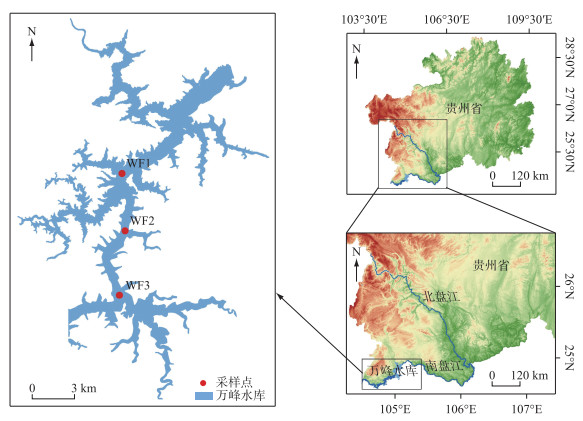
|
图 1 研究区位和采样点分布示意 Fig.1 The location and sampling sites of the study area |
目前,河湖沉积物磷形态的分级提取还没有统一的方法,研究根据Hedley等提出的方法[38-41],对沉积物各形态磷连续分步提取法进行改进,采用改进后的磷形态连续分步提取法进行提取,具体提取流程见附图 Ⅰ。将冷冻干燥后的沉积物样品(0.5 g)置于50 mL离心管中,依次用H2O、NaHCO3、NaOH和HCl萃取,获取上清液,采用紫外分光光度计测量上清液P浓度。分别获取弱吸附态有机磷(H2O-Po)、弱吸附态无机磷(H2O-Pi);潜在活性有机磷(NaHCO3-Po)、潜在活性无机磷(NaHCO3-Pi);铁铝结合态有机磷(Fe/Al-Po)、铁铝结合态无机磷(Fe/Al-Pi);钙结合态有机磷(Ca-Po)、钙结合态无机磷(Ca-Pi);残渣态磷(Res-P);有机磷(OP);无机磷(IP)和总磷(TP)。有机磷(OP)含量计算公式为:OP=TP-IP。
1.3 沉积物磷污染评价方法及标准为更好地评估水库沉积物磷污染水平,采用单因子污染指数和生物有效性指数法对水库沉积物磷污染程度进行评价分析[42-43]。
1) 单因子污染指数评价法公式为:
| $ S_i=C_i / C_{\mathrm{s}} $ | (1) |
式中,Si为单因子评价指数;Ci为评价因子的实测值;Cs为评价因子的标准值。TP的标准值Cs取为420 mg/kg[44-45]。
2) 生物有效性指数评价法公式为:
| $ S K_{\mathrm{P}}=K_{\mathrm{P}} \cdot S_i=K_{\mathrm{P}} \cdot C_i / C_{\mathrm{s}} $ | (2) |
| $ K_{\mathrm{P}}=C_{\mathrm{BAP}} /\left(C_{\mathrm{TP}}-C_{\mathrm{BAP}}\right) $ | (3) |
式中,SKP为生物有效性指数;KP为生物利用系数;Si、Ci和Cs的定义同公式(1);CBAP为生物有效性磷(BAP)的实测值;CTP为TP的实测值。
STP和SKP的评价标准如表 1所示。
| 表 1 沉积物磷污染指数评价标准 Tab. 1 Evaluation criteria of sediment phosphorus pollution index |
所有实验数据均在SPSS 20.2软件和Excel中进行统计分析;将相关性分析与地理探测器相结合,识别因子变量是否对结果变量的空间分布产生影响;运用ArcGIS 10.8、CorelDRAW X4 SP2及Origin 2021软件进行图件绘制。
2 结果与讨论 2.1 沉积物中P形态含量及空间分布 2.1.1 表层沉积物磷含量及其分布由图 2所示,表层沉积物中TP含量为116.45~348.14 mg/kg(均值194.44 mg/kg),IP含量为88.57~268.21 mg/kg,OP含量为3.81~9.5 mg/kg。Ca-P、H2O-P、NaHCO3-P、Fe/Al-P和Res-P的含量分别为22.79~69.2、21.93~68.18、22.01~67.46、25.79~72.88和23.26~70.43 mg/kg。与国内其他大型水库相比,万峰水库表层沉积物中TP含量处于较低水平(表 2),表层沉积物中TP含量均低于新丰江水库[46]、乌江渡水库[47]、潘家口水库[48]、金盆水库[49]、丹江口水库[50]、三峡水库[51]和密云水库[52]。空间分布上,表层沉积物中各形态磷含量的分布特征为WF3>WF1>WF2,且WF3的TP含量显著高于WF1、WF2,WF2含量最低,但与WF1差异较小。WF3(靠近革步乡)区域人类活动较为频繁、生活污水排放等致使磷营养盐在沉积物中不断累积,可能是造成该区域表层沉积物各形态磷含量较高的原因[53]。
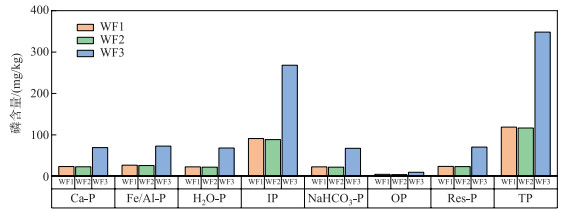
|
图 2 表层沉积物各形态磷的分布 Fig.2 Distribution of different types phosphorus in surface sediment |
| 表 2 不同水库表层沉积物TP含量比较 Tab. 2 Comparison of TP content in surface sediment of different reservoirs |
TP含量为79.37~438.04 mg/kg,平均含量为224.55 mg/kg,极值差高达5.5倍,空间异质性较为显著。各采样点沉积柱中TP含量也呈现出显著差异。WF1、WF2沉积柱中TP含量总体变化趋于一致,1~13 cm处TP含量总体变化较为平缓,而WF1沉积柱中的13~19 cm处TP含量呈上升趋势,WF3沉积柱TP含量总体上呈现出自上而下减少的趋势(图 3)。但各采样点沉积柱TP含量分布均存在突变趋势,这可能与水量变化导致的历史沉积改变和水生植物腐烂等因素有关[53]。
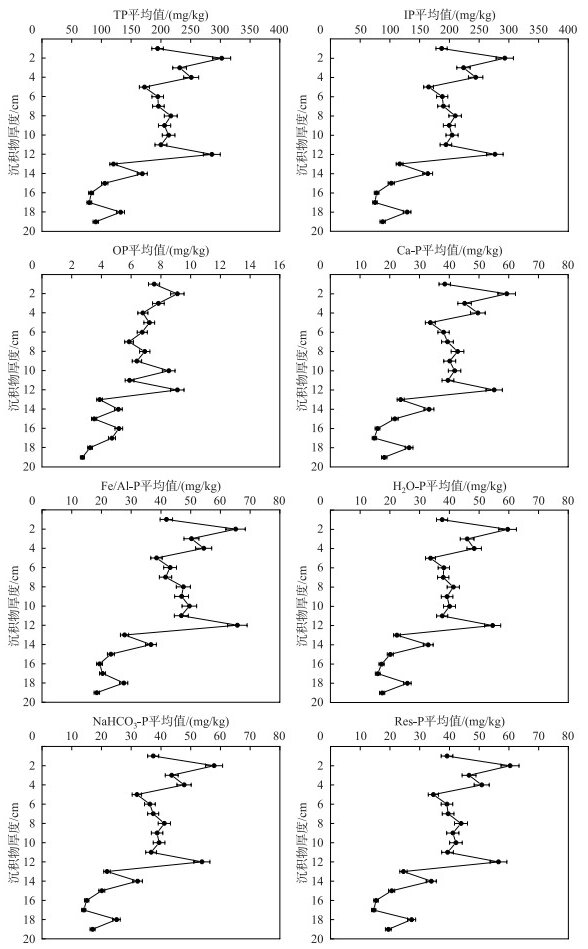
|
图 3 柱状沉积物形态磷的垂向分布 Fig.3 Vertical distribution of phosphorus forms in columnar sediment |
IP含量为60.91~337.88 mg/kg,平均含量174.82 mg/kg,占TP含量的73.26%~78.84%,均值为76.92%,是沉积物的主要赋存形态。IP与TP之间具有较好的相关性(相关系数r=0.994,P<0.01,n=47),且IP与TP分布趋势整体趋于一致,沉积物TP与IP具有同源性。IP含量在沉积柱中,随着深度的增加WF1、WF2沉积物各形态IP含量呈出一定程度增加的趋势,而WF3则呈现出随着深度的增加各形态IP含量减少的趋势(图 3)。
OP含量为1.84~13.59 mg/kg,平均含量为6.55 mg/kg,占TP的2.92%。在沉积柱中WF2、WF3采样点表层沉积物OP明显高于底层,并且与沉积厚度呈负相关,其中WF3靠近城市区域,受人类活动的影响较大,并且是蒙里河、红染河的汇合口,为有机物的堆积提供了重要条件。WF1沉积物OP含量随厚度的增加,整体上呈增加趋势,最高值为13.59 mg/kg(图 3)。
沉积物中磷形态含量趋势为Fe/Al-P>Res-P>Ca-P>H2O-P>NaHCO3,空间分布具有一定的差异性。各点位沉积柱中磷赋存形态的变化趋势一致,且与TP的变化趋于一致。各形态磷所占比例较为相近,没有显著差异。NaHCO3-P所占比例最低,占TP的19.52%~19.49%(均值18.69%)。Fe/Al-P含量占比最高,含量为17.34~94.39 mg/kg(均值49.86 mg/kg),占TP的20.4%~31.38%(均值22.41%)(图 3)。沉积物中的Fe/Al-P容易受pH值和氧化还原电位的影响,且受人为活动和外源输入影响较大[54],可以反映湖泊受污染情况,含量越高说明污染情况越重[55]。Res-P的平均含量为44.92 mg/kg,占TP的20.05%;Ca-P的平均含量为44.15 mg/kg,占TP的19.6%,沉积物中Res-P和Ca-P被认为是相对稳定的惰性磷,不易与上覆水体进行磷交换,一般的环境条件变化难以对该形态磷的迁移转化产生影响[49, 56]。
WF1位于万峰湖一号港口,靠近南盘江镇,容易受到人类活动影响,生活污水以及废水容易排放到湖泊中,增加磷酸盐浓度,且该区域湖面广阔,水流缓慢。WF2位于南盘江干流,周围以林地为主,距离居民点较远,人类活动对于水体磷酸盐浓度的影响较低。WF3靠近革步乡,受人类活动的影响较大,且是蒙里河、红染河的汇合口,河流携带的泥沙极易沉积,除此之外,在未建水库以前该区域属于农田,早期的水稻土因为人类农业活动吸附了大量的营养盐,这可能是造成各点位沉积物中不同形态磷含量和空间分布差异的原因。
2.2 沉积物各形态IP含量及分布特征IP是沉积物中磷素的主要组成部分,可直接被水生植物吸收和利用[57]。沉积物IP形态包括Ca-Pi、H2O-Pi、NaHCO3-Pi、Fe/Al-Pi和Res-Pi。万峰水库沉积物各形态IP含量及分布特征如图 4所示,各形态IP含量为Fe/Al-Pi>Ca-Pi>NaHCO3-Pi>H2O-Pi,H2O-Pi是极易迁移的磷形态,主要来源于间隙水[58]。H2O-Pi含量为14.43~82.13 mg/kg (均值41.21 mg/kg),在无机磷形态中占比最小,但总体含量远高于三峡水库(8.40 mg/kg)[59]。Ca-Pi含量为14.98~82.65 mg/kg(均值42.48 mg/kg),NaHCO3-Pi含量为14.64~83.30 mg/kg(均值41.23 mg/kg)。Fe/Al-Pi含量为16.86~91.82 mg/kg(均值48.15 mg/kg),在无机磷形态中占比最高(为36.41%),表明Fe/Al-Pi是沉积物无机磷的主要赋存形态。
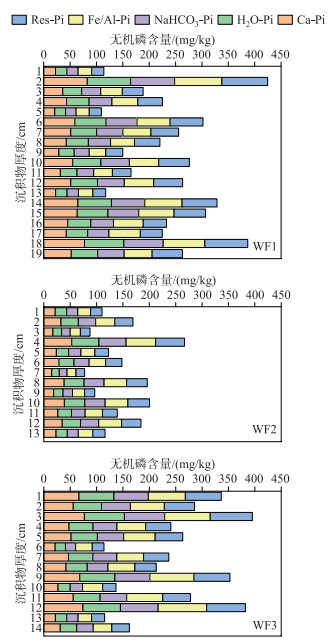
|
图 4 沉积物无机磷形态含量及空间分布 Fig.4 Content and spatial distribution of inorganic phosphorus forms in sediment |
沉积物OP形态分为Ca-Po、H2O-Po、NaHCO3-Po、Fe/Al-Po和Res-Po。万峰水库沉积物中各形态OP含量及分布特征如图 5所示。各形态OP含量表现为H2O-Po>Fe/Al-Po>Ca-Po>NaHCO3-Po。H2O-Po与H2O-Pi相似,是极易迁移的磷形态,H2O-Po在OP形态中占比最高,含量为0.27~8.03 mg/kg(均值2.21 mg/kg),占OP的33.76%,是沉积物OP的主要赋存形态。Fe/Al-Po含量为0.47~8.57 mg/kg(均值1.71 mg/kg)。Ca-Po指与钙、镁结合的有机磷,万峰水库Ca-Po含量为0.50~3.63 mg/kg(1.66 mg/kg)。NaHCO3-Po含量最低,为0.14~2.48 mg/kg(均值0.97 mg/kg),仅占OP的14.78%。
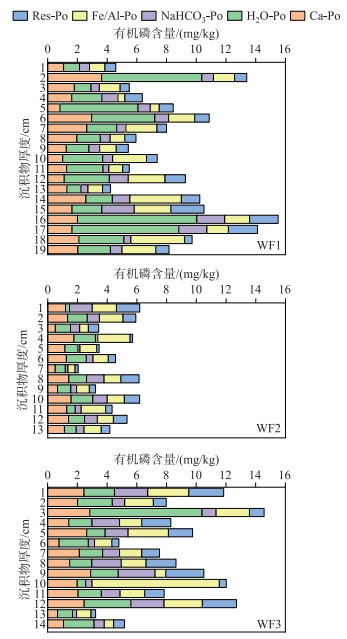
|
图 5 沉积物各形态有机磷含量及分布 Fig.5 Content and spatial distribution of organic phosphorus forms in sediment |
相关性分析与地理探测器相结合是一种综合分析方法,用于揭示变量之间的关系以及其对空间分布的影响。本研究综合应用地理探测器模型中的交互因子探测器和相关性分析,可以通过计算相关系数和交互因子的贡献率来评估变量之间的关系和相互作用,揭示变量之间的相互作用机制及相互影响[60]。如图 6所示,TP空间分异的驱动力因素为Res-P>H2O-Pi>Ca-Pi>NaHCO3-Pi>Fe/Al-Pi>Ca-Po>H2O-Po>Fe/Al-Po>NaHCO3-Po>厚度。其中Res-P、H2O-Pi、Ca-Pi、NaHCO3-Pi、Fe/Al-Pi对TP的空间分布影响显著大于Ca-Po、H2O-Po、Fe/Al-Po、NaHCO3-Po和厚度,对TP的空间分异具有极强的影响力,是沉积物各形态磷空间分异的主要驱动力。Fe/Al-Pi的来源主要为生活污水、工业废水,是人类活动的重要体现,与Ca-Po、H2O-Po、NaHCO3-Po、沉积物厚度均存在显著差异,表明人类生产活动对于沉积物营养盐的影响较大。
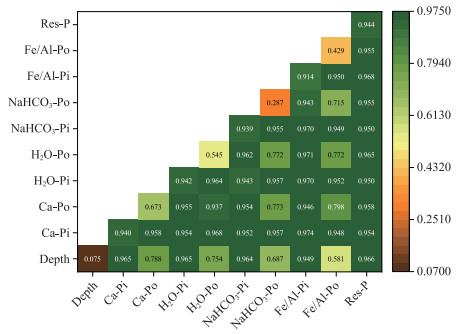
|
图 6 沉积物磷赋存形态交互作用强度 Fig.6 Interaction intensity of phosphorus occurrence in sediment |
运用交互探测器对因素联合作用进行分析显示,因子共同作用增强了对TP空间分异的解释力,并且影响类型为双变量增强、双变量非线性增强。其中厚度-Ca-Pi、厚度-H2O-Pi、厚度-NaHCO3-Pi、厚度-Fe/Al-Pi的联合影响力明显高于单一因素,表明沉积物的深度对于TP具有多重作用,与其他因素的共同作用显著。Ca-Pi、Fe/Al-Pi、H2O-Pi、NaHCO3-Pi与其他因素的共同因子解释强度均超过90%,表明沉积物中无机磷相互转化极其显著,而有机磷的矿化能力相对较弱。交互探测器分析表明,Res-P与其他形态磷的交互作用强度均高于94%,可能是因为沉积物中残渣磷具有较高的稳定性,不易向其他形态的无机磷转化。
2.5 沉积物生物有效性磷及污染评价 2.5.1 生物有效性磷(BAP)沉积物中BAP是指能以溶解态的磷酸盐释放出来可被水生生物利用的活性磷含量,可用于评价沉积物磷的释放潜力,从而评价磷的污染水平[61-62]。目前,生物有效磷尚未有统一界定,不同学者对生物有效磷的种类划分还不尽相同[47, 62]。沉积物中H2O-P、NaHCO3-P是极易迁移的磷形态且易释放于水体;Fe/Al-Pi在pH、氧化还原电位变化时易发生迁移转化,具有潜在生物有效性;Res-P和Ca-P被认为是相对稳定的惰性磷,不易与上覆水体进行磷交换[49, 53, 56]。因此根据采样的实际情况,将H2O-P、Fe/Al-P、NaHCO3-P之和作为潜在的BAP,根据实测结果计算出BAP的含量及BAP在TP中所占比例。
如图 7所示,万峰水库BAP含量为66.97~201.46 mg/kg,平均含量为130.59 mg/kg,低于三峡水库(200.0 mg/kg)[63]、新丰江水库[46](243.9 mg/kg)。库区内沉积物BAP含量波动较大,空间异质性较为显著,WF3采样点的BAP含量最高,显著高于WF1、WF2。
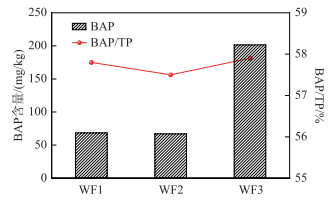
|
图 7 沉积物BAP含量及BAP/TP值 Fig.7 BAP content and BAP/TP values in sediments |
万峰水库BAP/TP值的变化范围为55.6%~59.6%,均值为58.1%,明显高于三峡水库[63](33.0%)、新丰江水库[46](29.2%~46.5%)和向家坝水库[4](6.2%~17.1%)。其中表层沉积物BAP/TP值为57.5%~57.9%,呈WF1<WF2<WF3的空间分布特征,与TP空间分异特征一致。随着沉积物厚度的增加,WF2沉积柱中BAP的比重变化趋势最为明显,BAP在沉积柱中的组成结构差异性较大,呈WF1沉积物柱中的有效磷比重递减,WF3呈增长态势,表明沉积物中磷的组成结构决定了磷污染水平的高低。万峰水库各点位的BAP/TP值均高于55%,可知万峰水库存在沉积物内源磷释放风险,内源磷对上覆水体的释放风险不容忽视[64]。
2.5.2 沉积物磷污染特征评价根据磷污染指数的评价方法和标准,万峰水库沉积物磷污染等级评价结果如表 3所示。万峰水库沉积物TP污染指数(STP)的变化范围为0.19~1.04,均值为0.53,采样点的整体污染程度较轻。其中,WF1的污染指数范围为0.28~1.04,均值为0.59;WF2的污染指数范围为0.19~0.65,均值为0.36;WF3的污染指数范围为0.28~0.98,均值为0.62。WF2点位的平均污染指数STP<0.5,为清洁状态(Ⅰ);WF1、WF3点位的平均污染指数0.5≤STP≤1,处于轻度污染水平(Ⅱ)。
| 表 3 万峰水库沉积物磷污染评价指数 Tab. 3 Evaluation criteria of phosphorus pollution in sediments of Wanfeng Reservoir |
万峰水库沉积物生物有效性指数(SKP)范围为0.28~1.58,均值为0.81,采样点的整体污染程度为轻度污染水平(Ⅱ)。其中,WF1的生物有效性指数范围为0.43~1.58,均值为0.89;WF2的生物有效性指数范围为0.28~0.96,均值为0.55;WF3的生物有效性指数范围为0.42~1.52,均值为0.96。WF1、WF2和WF3点位的平均生物有效性指数为0.5≤SKP≤1,根据评价标准可知WF1、WF2和WF3点位均处于轻度污染水平(Ⅱ)。
TP污染指数和生物有效性指数评价结果均表明,万峰水库沉积物磷污染整体处于轻度污染水平(Ⅱ),各点位之间的磷污染水平较为接近,空间分布特征呈WF3>WF2>WF1,与TP空间分异特征一致。WF3靠近人类活动区域,人类活动对沉积环境的影响更为突出,且WF3为蒙里河与红染河汇合处,水环境不稳定,容易引起沉积物氧化还原反应和无机磷的扩散交替发生,这可能是WF3的污染高于WF1和WF2的原因[53, 64]。
综上研究表明,尽管目前万峰水库沉积物磷污染水平较轻,但库区沉积物中生物有效磷占总磷的比值值较高,仍存在潜在的内源磷污染上覆水体风险。未来,此类岩溶峡谷型水库沉积物中各形态磷的释放可能会导致水库水质恶化,建议岩溶峡谷型水库在控制外源磷输入的同时,也应加强对内源磷的管理,以降低内源磷释放污染上覆水体的风险。
3 结论1) 水库沉积物TP含量为79.37~438.04 mg/kg,平均含量224.55 mg/kg,空间异质性显著。IP、OP含量分别为60.91~337.88 mg/kg(均值174.82 mg/kg)和1.84~13.59 mg/kg(均值6.55 mg/kg),IP占TP的比例为73.26%~78.84%,是沉积物磷的主要赋存形态。Fe/Al-Pi含量为16.86~91.82 mg/kg(均值48.15 mg/kg),占IP的比例最高为36.41%,是IP的主要赋存形态。H2O-Po量为0.27~8.03 mg/kg(均值2.21 mg/kg),占OP的33.76%,是OP的主要赋存形态。
2) Res-P、H2O-Pi、Ca-Pi、NaHCO3-Pi、Fe/Al-Pi对TP空间分异具有极强的影响力,是沉积物各形态磷空间分异的主要驱动力。沉积物的厚度对于TP具有多重作用,与其他因素的共同作用显著。
3) 水库沉积物BAP含量为66.97~201.46 mg/kg,空间异质性较为显著,且与TP空间分异特征一致。BAP/TP值的变化范围为55.6%~59.6%,各点位的BAP/TP值均高于55%;水库沉积物TP污染指数(STP)变化范围为0.19~1.04,均值0.53(清洁),生物有效性指数(SKP)范围为0.28~1.58,均值0.81(轻度)。沉积物磷污染程度整体处于轻度污染,但仍存在内源磷污染上覆水体风险。建议此类岩溶峡谷型水库在控制外源磷输入的同时,也应加强对内源磷的管理,以降低内源磷释放污染上覆水体的风险。
4 附录附图 Ⅰ见电子版(DOI: 10.18307/2024.0426)。
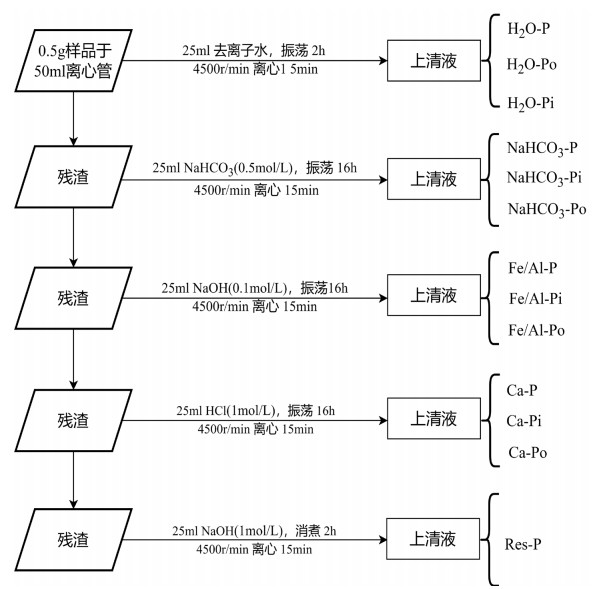
|
附图Ⅰ 改进的磷形态连续提取流程 AttachedFigure1 Flowchart of improved continuous extraction process for phosphorus forms |
| [1] |
Guo JB, Zhang CJ, Zheng GC et al. The establishment of season-specific eutrophication assessment standards for a water-supply reservoir located in Northeast China based on chlorophyll-a levels. Ecological Indicators, 2018, 85: 11-20. DOI:10.1016/j.ecolind.2017.09.056 |
| [2] |
Han N, Yuan XY, Zhou HH et al. Distribution characteristics of organic phosphorus in the sediments of rivers entering the Lake Hongze and the effects of exogenous substances on their fraction transformation. J Lake Sci, 2020, 32(3): 665-675. [韩年, 袁旭音, 周慧华等. 洪泽湖入湖河流沉积物有机磷分布特征及外源输入对其形态转化的影响. 湖泊科学, 2020, 32(3): 665-675. DOI:10.18307/2020.0307] |
| [3] |
Varol M. Spatio-temporal changes in surface water quality and sediment phosphorus content of a large reservoir in Turkey. Environmental Pollution, 2020, 259: 113860. DOI:10.1016/j.envpol.2019.113860 |
| [4] |
Li QX, Jin HH, Zhao HP et al. Distribution characteristics of sediments phosphorus species of Xiangjiaba Reservoir and release risk. Acta Scientiae Circumstantiae, 2022, 42(9): 182-190. [李清雪, 靳慧慧, 赵海萍等. 向家坝库区沉积物磷形态分布及释放风险. 环境科学学报, 2022, 42(9): 182-190. DOI:10.13671/j.hjkxxb.2022.0068] |
| [5] |
Wang XQ, Ruan WY, Yi KK. Internal phosphate starvation signaling and external phosphate availability have no obvious effect on the accumulation of cadmium in rice. Journal of Integrative Agriculture, 2019, 18(9): 2153-2161. DOI:10.1016/s2095-3119(18)62100-8 |
| [6] |
Zhu YR, Feng WY, Liu SS et al. Bioavailability and preservation of organic phosphorus in lake sediments: Insights from enzymatic hydrolysis and 31P nuclear magnetic resonance. Chemosphere, 2018, 211: 50-61. DOI:10.1016/j.chemosphere.2018.07.134 |
| [7] |
Cui H, Ou Y, Wang LX et al. Distribution and release of phosphorus fractions associated with soil aggregate structure in restored wetlands. Chemosphere, 2019, 223: 319-329. DOI:10.1016/j.chemosphere.2019.02.046 |
| [8] |
Zhu Y, Li YP, Tang CY et al. Effects of the disappearance of seasonal thermal stratification on the mobilization of iron and phosphorus in reservoirs, Southern China—A case of Tianbao Reservoir, Nanning City. J Lake Sci, 2021, 33(4): 1153-1162. [朱雅, 李一平, 唐春燕等. 南方水库季节性热分层消亡对沉积物铁和磷迁移的影响——以南宁市天雹水库为例. 湖泊科学, 2021, 33(4): 1153-1162. DOI:10.18307/2021.0416] |
| [9] |
Jiang J, Long YC, Yao XQ et al. Fraction distribution and release risk analysis of phosphorus in sediments from Caohai, Guizhou. Acta Scientiae Circumstantiae, 2022, 42(7): 347-358. [蒋娟, 龙云川, 姚小琴等. 贵州草海沉积物磷形态分布及释放风险分析. 环境科学学报, 2022, 42(7): 347-358. DOI:10.13671/j.hjkxxb.2021.0446] |
| [10] |
Wu FC, Jin XC, Zhang RY et al. Effects and significance of organic nitrogen and phosphorous in the lake aquatic environment. J Lake Sci, 2010, 22(1): 1-7. [吴丰昌, 金相灿, 张润宇等. 论有机氮磷在湖泊水环境中的作用和重要性. 湖泊科学, 2010, 22(1): 1-7. DOI:10.18307/2010.0101] |
| [11] |
Qin BQ, Zhang YL, Yang GJ et al. Dynamics of variability and mechanism of harmful cyanobacteria bloom in Lake Taihu, China. Chinese Science Bulletin, 2016, 61(7): 759-770. [秦伯强, 张运林, 杨桂军等. 太湖蓝藻水华"暴发"的动态特征及其机制. 科学通报, 2016, 61(7): 759-770.] |
| [12] |
Wang JF, Chen JA, Chen Q et al. Biogeochemical cycling of phosphorus in deep-water reservoirs. Quaternary Sciences, 2021, 41(4): 1192-1205. [王敬富, 陈敬安, 陈权等. 深水水库磷的生物地球化学循环. 第四纪研究, 2021, 41(4): 1192-1205.] |
| [13] |
Bloom AL. Water-formed structures: Geomorphology and hydrology of Karst terrains. Science, 1989, 243(4898): 1618-1619. DOI:10.1126/science.243.4898.1618-a |
| [14] |
Wang WF, Yi YB, Zhong J et al. Carbon biogeochemical processes in a subtropical Karst River-reservoir system. Journal of Hydrology, 2020, 591: 125590. DOI:10.1016/j.jhydrol.2020.125590 |
| [15] |
Wang WY, Li QG. The buffering effect of chemical equilibrium of CaCO3-CO32--HCO3--CO2 on CO2 in freshwater carbonate lake—A case study from Baihua Lake, Guizhou. Carsologica Sinica, 2021, 40(4): 572-579. [王晤岩, 李清光. 淡水碳酸盐湖泊中CaCO3-CO32--HCO3--CO2化学平衡对CO2的缓冲作用——以贵州百花湖为例. 中国岩溶, 2021, 40(4): 572-579.] |
| [16] |
Yan N, Chen C. The distribution of phytoplankton and water quality evaluation in wujiangdu reservoir, a canyon-style reservoir, Guizhou. Guizhou Science, 2011, 29(2): 69-75. [晏妮, 陈椽. 贵州干流峡谷型水库——乌江渡水库浮游植物分布及水质现状分析. 贵州科学, 2011, 29(2): 69-75.] |
| [17] |
Otsuki A, Wetzel RG. Coprecipitation of phosphate with carbonates in a marl lake. Limnology and Oceanography, 1972, 17(5): 763-767. DOI:10.4319/lo.1972.17.5.0763 |
| [18] |
Sun HL, Han CH, Liu ZH et al. Nutrient limitations on primary productivity and phosphorus removal by biological carbon pumps in dammed Karst Rivers: Implications for eutrophication control. Journal of Hydrology, 2022, 607: 127480. DOI:10.1016/j.jhydrol.2022.127480 |
| [19] |
Chen JA, Wang JF, Yu J et al. Eco-environmental characteristics of reservoirs in southwest China and their research prospects. Earth and Environment, 2017, 45(2): 115-125. [陈敬安, 王敬富, 于佳等. 西南地区水库生态环境特征与研究展望. 地球与环境, 2017, 45(2): 115-125.] |
| [20] |
Yuan ZY, Cao YP, Jiao SL. Analysis of temporal and spatial variation characteristics on water environment in Malinghe River backwater area of Karst Plateau Reservoir. Journal of Shandong Agricultural University: Natural Science Edition, 2019, 50(4): 582-586. [袁子勇, 曹玉平, 焦树林. 喀斯特高原水库马岭河回水区水环境时空变化特征分析. 山东农业大学学报: 自然科学版, 2019, 50(4): 582-586. DOI:10.3969/j.issn.1000-2324.2019.04.009] |
| [21] |
Yuan ZH, Li QH, He Y et al. Variation and evaluation of nutrients in Baihua Reservoir in Guizhou Plateau based on Bayesian method, 2014-2018. J Lake Sci, 2019, 31(6): 1623-1636. [袁振辉, 李秋华, 何应等. 基于贝叶斯方法的贵州高原百花水库水体营养盐变化及评价(2014-2018年). 湖泊科学, 2019, 31(6): 1623-1636. DOI:10.18307/2019.0602] |
| [22] |
Jiao S, Tao Z, Gao Q et al. Stable isotopic composition of riverine dissolved inorganic carbon of the Xijiang River Inner Estuary. Journal of Geographical Sciences, 2008, 18(3): 363-372. DOI:10.1007/s11442-008-0363-3 |
| [23] |
Zhao ZQ, Suo HY, Jiao SL. Source and spatio-temporal variation characteristics of dissolved inorganic carbon in Wanfenghu Reservoir, China. Chinese Journal of Applied Ecology, 2020, 31(6): 1783-1790. [赵宗权, 索惠英, 焦树林. 万峰湖水库溶解性无机碳来源及时空变异特征. 应用生态学报, 2020, 31(6): 1783-1790. DOI:10.13287/j.1001-9332.202006.028] |
| [24] |
Ma S, Wei Y, Han CH et al. Hydrochemical characteristics in Karst Reservoirs and its implication for inorganic carbon deposition fluxes. J Lake Sci, 2021, 33(6): 1701-1713. [马松, 魏榆, 韩翠红等. 喀斯特水库水化学特征及对无机碳沉积通量的指示. 湖泊科学, 2021, 33(6): 1701-1713. DOI:10.18307/2021.0608] |
| [25] |
Yi YB, Wang WF, Wang BL et al. Research progress on the dissolved and particulate carbon of reservoirs in Karst areas of Southwest China. Bulletin of Geological Science and Technology, 2022, 41(5): 341-346. [易沅壁, 王万发, 王宝利等. 中国西南喀斯特地区水库溶解态与颗粒态碳研究进展. 地质科技通报, 2022, 41(5): 341-346.] |
| [26] |
Li QH, Han LB, Ma YM et al. The relationship between and Cyanobacteria composition characteristics environmental factors in Hongfeng Reservoir of Guizhou Plateau. Journal of Guizhou Normal University: Natural Sciences, 2021, 39(6): 1-7, 134. [李秋华, 韩丽彬, 马一明等. 贵州高原红枫水库蓝藻组成特征与环境因子之间的关系. 贵州师范大学学报: 自然科学版, 2021, 39(6): 1-7, 134. DOI:10.16614/j.gznuj.zrb.2021.06.001] |
| [27] |
Han LB, Wang X, Li QH et al. Dynamic changes and driving factors of phytoplankton functional groups in Baihua Reservoir, Guizhou Plateau. J Lake Sci, 2022, 34(4): 1102-1114. [韩丽彬, 王星, 李秋华等. 贵州高原百花水库浮游植物功能群的动态变化及驱动因子. 湖泊科学, 2022, 34(4): 1102-1114. DOI:10.18307/2022.0405] |
| [28] |
Ge QS, Zhang P, Ni MF et al. Relationships between phytoplankton and environmental factors in A typical Karst Plateau Reservoir. Ecology and Environmental Sciences, 2021, 30(1): 156-164. [葛秋诗, 张萍, 倪茂飞等. 典型喀斯特高原水库浮游植物与环境因子的关系. 生态环境学报, 2021, 30(1): 156-164.] |
| [29] |
Han LB, Li QH, Chen WS et al. The key environmental factors driving the succession of phytoplankton functional groups in Hongfeng Reservoir, southwest China. Journal of Oceanology and Limnology, 2022, 40(4): 1472-1484. DOI:10.1007/s00343-021-1120-z |
| [30] |
Ma YM, Li QH, Pan SP et al. Dynamic analysis of niche and interspecific association of dominant phytoplankton species in Huaxi Reservoir of Guizhou Plateau. J Lake Sci, 2021, 33(3): 785-796. [马一明, 李秋华, 潘少朴等. 贵州高原花溪水库浮游植物优势种生态位及种间联结性动态分析. 湖泊科学, 2021, 33(3): 785-796. DOI:10.18307/2021.0314] |
| [31] |
Guan TH, Li XD, Wang YY et al. Distribution characteristics, influencing factors and sources of heavy metals in Karst deep-water reservoirs: A case study of Longtan Reservoir. Journal of Shanghai University: Natural Science Edition, 2021, 27(2): 236-249. [关天昊, 李晓东, 王亦尧等. 喀斯特地区深水型水库重金属分布特征、影响因素及来源——以龙滩水库为例. 上海大学学报: 自然科学版, 2021, 27(2): 236-249. DOI:10.12066/j.issn.1007-2861.2289] |
| [32] |
Kuang P, Li QH, Jin S et al. Spatial and temporal distribution of heavy metals in water environment of Puding Reservoir in Guizhou Province and risk assessment. Research of Environmental Sciences, 2021, 34(3): 576-588. [旷攀, 李秋华, 金爽等. 贵州高原普定水库水环境重金属的时空分布特征及风险评价. 环境科学研究, 2021, 34(3): 576-588. DOI:10.13198/j.issn.1001-6929.2020.10.24] |
| [33] |
Zhang W, Zhang LL. Distribution characteristics and pollution assessment of heavy metals in water and sediments of Aha Reservoir of Guizhou in different seasons. Chinese Journal of Ecology, 2021, 40(6): 1753-1765. [张伟, 张丽丽. 贵州阿哈水库不同季节水体和沉积物重金属分布特征及污染评价. 生态学杂志, 2021, 40(6): 1753-1765. DOI:10.13292/j.1000-4890.202106.006] |
| [34] |
Xiao X, Long J, Zhang RY et al. Diffusion fluxes of heavy metals at the sediment-water interface during summer and winter from Aha Reservoir, Guiyang. Chinese Journal of Ecology, 2019, 38(5): 1508-1519. [肖雄, 龙健, 张润宇等. 阿哈水库沉积物-水界面重金属扩散通量. 生态学杂志, 2019, 38(5): 1508-1519. DOI:10.13292/j.1000-4890.201905.012] |
| [35] |
He Y, Li QH, Tang L et al. Evaluation and source analysis of heavy metal pollution in sediments of Hongfeng Reservoir in Guizhou Province, China. Chinese Journal of Ecology, 2019, 38(3): 799-809. [何应, 李秋华, 唐黎等. 贵州红枫水库沉积物重金属污染评价及来源分析. 生态学杂志, 2019, 38(3): 799-809. DOI:10.13292/j.1000-4890.201903.003] |
| [36] |
Tang L, Li QH, Chen C et al. Distribution and pollution characteristics of heavy metals in sediments of Puding Reservoir, Guizhou Province. China Environmental Science, 2017, 37(12): 4710-4721. [唐黎, 李秋华, 陈椽等. 贵州普定水库沉积物重金属分布及污染特征. 中国环境科学, 2017, 37(12): 4710-4721. DOI:10.3969/j.issn.1000-6923.2017.12.037] |
| [37] |
Li QH, Shang LH, Gao TJ et al. Eutrophication characteristics of a Karst Plateau deep-water Wanfeng Reservoir. Ecological Science, 2013, 32(2): 194-199. [李秋华, 商立海, 高廷进等. 喀斯特高原深水水库——万峰湖富营养化特征分析. 生态科学, 2013, 32(2): 194-199. DOI:10.3969/j.issn.1008-8873.2013.02.010] |
| [38] |
Hedley MJ, Stewart JWB, Chauhan BS. Changes in inorganic and organic soil phosphorus fractions induced by cultivation practices and by laboratory incubations. Soil Science Society of America Journal, 1982, 46(5): 970-976. DOI:10.2136/sssaj1982.03615995004600050017x |
| [39] |
Liang Z, Liu ZM, Zhen SM et al. Phosphorus speciation and effects of environmental factors on release of phosphorus from sediments obtained from Taihu Lake, Tien Lake, and East Lake. Toxicological & Environmental Chemistry, 2015, 97(3/4): 335-348. DOI:10.1080/02772248.2015.1050186 |
| [40] |
Sun M, Bao YF, Wang YCH et al. Characteristics of phosphorus fractions distribution and release risk of sediment in the middle and lower reaches of Lancang River cascade reservoirs. China Environmental Science, 2023, 43(7): 3634-3643. [孙猛, 包宇飞, 王雨春等. 澜沧江中下游梯级水库沉积物磷形态分布特征及释放风险. 中国环境科学, 2023, 43(7): 3634-3643. DOI:10.3969/j.issn.1000-6923.2023.07.039] |
| [41] |
Zhang ZB, Wang SY, Zhang YH et al. Fractions and distribution characteristics of organic phosphorus in the sediment of the water level fluctuation zone of Lake Nansi. J Lake Sci, 2023, 35(5): 1647-1658. [张志斌, 王书义, 张彦浩等. 南四湖消落带底泥有机磷赋存形态及分布特征. 湖泊科学, 2023, 35(5): 1647-1658. DOI:10.18307/2023.0525] |
| [42] |
Fang YJ, Xie XM, Li B. Distribution of phosphorus forms in sediment of Rubber Dam Reservoir in Yihe River, Shandong Province. Environmental Science & Technology, 2023, 46(9): 188-196. [房垠婧, 解晓敏, 李宝. 山东沂河橡胶坝蓄水段沉积物磷形态分布. 环境科学与技术, 2023, 46(9): 188-196.] |
| [43] |
Zhang HD, Dang N, Lin XF et al. Distribution characteristics of nutrients and pollution status evaluation of sediments in Changtan Reservoir. Research of Soil and Water Conservation, 2023, 30(2): 438-443, 450. [张涵丹, 党宁, 林雪锋等. 长潭水库水体沉积物营养盐分布特征及其污染评价. 水土保持研究, 2023, 30(2): 438-443, 450.] |
| [44] |
Wang YP, Xu WW, Han C et al. Distribution of nitrogen and phosphorus in Lake Chaohu sediments and pollution evaluation. Environmental Science, 2021, 42(2): 699-711. [王艳平, 徐伟伟, 韩超等. 巢湖沉积物氮磷分布及污染评价. 环境科学, 2021, 42(2): 699-711. DOI:10.13227/j.hjkx.202006216] |
| [45] |
张敏. 长江中下游浅水湖泊富营养化机制与重金属污染研究[学位论文]. 武汉: 中国科学院水生生物研究所, 2005.
|
| [46] |
Chen R, Zhou W, Qiao YM et al. Phosphorus speciations and its distribution characteristics in sediments of Xinfengjiang Reservoir. Journal of Hydroecology, 2023, 11(27): 1-12. [陈瑞, 周雯, 乔永民等. 新丰江水库沉积物磷赋存形态及分布特征. 水生态学杂志, 2023, 11(27): 1-12.] |
| [47] |
Hu XP, Li PY, Wang JF et al. Characteristics of phosphorus in sediment of the Wujiangdu Reservoir and its responses to damming. Earth and Environment, 2022, 50(6): 805-812. [胡鑫平, 李庞义, 王敬富等. 乌江渡沉积物磷的污染特征及其对河流筑坝的响应. 地球与环境, 2022, 50(6): 805-812.] |
| [48] |
Wang HW, Wang SM, Zhang M et al. Occurrence characteristics and transport fluxes of nitrogen and phosphorus at sediment-water interface of Panjiakou Reservoir in spring. China Environmental Science, 2021, 41(9): 4284-4293. [王洪伟, 王少明, 张敏等. 春季潘家口水库沉积物-水界面氮磷赋存特征及迁移通量. 中国环境科学, 2021, 41(9): 4284-4293.] |
| [49] |
Mao XJ, Huang TL, Li N et al. Sources and distribution of phosphorus in sediments of the Jinpen Reservoir. Environmental Science, 2019, 40(6): 2738-2744. [毛雪静, 黄廷林, 李楠等. 金盆水库沉积物磷的来源及分布特征. 环境科学, 2019, 40(6): 2738-2744. DOI:10.13227/j.hjkx.201810220] |
| [50] |
Li B, Wang Y, Zheng Z et al. Temporal and spatial changes in sediment nutrients and heavy metals of the Danjiangkou Reservoir before and after water division of the mid-route project. Environmental Science, 2018, 39(8): 3591-3600. [李冰, 王亚, 郑钊等. 丹江口水库调水前后表层沉积物营养盐和重金属时空变化. 环境科学, 2018, 39(8): 3591-3600. DOI:10.13227/j.hjkx.201801003] |
| [51] |
Zhuo HH, Qiu GS, Zhai WY et al. Evaluation of temporal and spatial variation characteristics of nutrients in surface sediment in the Three Gorges Reservoir Area. Environmental Science, 2017, 38(12): 5020-5031. [卓海华, 邱光胜, 翟婉盈等. 三峡库区表层沉积物营养盐时空变化及评价. 环境科学, 2017, 38(12): 5020-5031. DOI:10.13227/j.hjkx.201705127] |
| [52] |
Qin LH, Zeng QH, Li XY et al. The distribution characteristics of P forms in Miyun Reservoir sediments. Chinese Journal of Ecology, 2017, 36(3): 774-781. [秦丽欢, 曾庆慧, 李叙勇等. 密云水库沉积物磷形态分布特征. 生态学杂志, 2017, 36(3): 774-781. DOI:10.13292/j.1000-4890.201703.023] |
| [53] |
Du YH, Liu C, Chen KN et al. Occurrence and internal loadings of nitrogen and phosphorus in the sediment of Lake Baiyangdian. J Lake Sci, 2018, 30(6): 1537-1551. [杜奕衡, 刘成, 陈开宁等. 白洋淀沉积物氮磷赋存特征及其内源负荷. 湖泊科学, 2018, 30(6): 1537-1551. DOI:10.18307/2018.0606] |
| [54] |
Jin XC, Pang Y, Wang SR et al. Phosphorus forms and its distribution character in sediment of shallow lakes in the middle and lower reaches of the Yangtze River. Journal of Agro-Environment Science, 2008, 27(1): 279-285. [金相灿, 庞燕, 王圣瑞等. 长江中下游浅水湖沉积物磷形态及其分布特征研究. 农业环境科学学报, 2008, 27(1): 279-285. DOI:10.3321/j.issn:1672-2043.2008.01.051] |
| [55] |
Zhao HC, Wang SR, Jiao LX et al. Characteristics of temporal and spatial distribution of different forms of phosphorus in the sediments of Erhai Lake. Research of Environmental Sciences, 2013, 26(3): 227-234. [赵海超, 王圣瑞, 焦立新等. 洱海沉积物中不同形态磷的时空分布特征. 环境科学研究, 2013, 26(3): 227-234. DOI:10.13198/j.res.2013.03.6.zhaohch.006] |
| [56] |
Xie FZ, Luo K, Zhu YR et al. Characteristics of phosphorus fractions in sediments and its influence on the water quality of Lake Nanyi. China Environmental Science, 2022, 42(11): 5318-5327. [谢发之, 罗锟, 朱元荣等. 南漪湖沉积物磷的赋存形态及对上覆水的影响. 中国环境科学, 2022, 42(11): 5318-5327.] |
| [57] |
Pan CR, Wang JQ, Zheng ZX et al. Forms of phosphorus and nitrogen existing in sediments in Chaohu Lake. Journal of Ecology and Rural Environment, 2007, 90(1): 43-47. [潘成荣, 汪家权, 郑志侠等. 巢湖沉积物中氮与磷赋存形态研究. 生态与农村环境学报, 2007, 90(1): 43-47.] |
| [58] |
Sun SJ, Huang SL, Sun XM et al. Phosphorus fractions and its release in the sediments of Haihe River, China. Journal of Environmental Sciences: China, 2009, 21(3): 291-295. DOI:10.1016/s1001-0742(08)62266-4 |
| [59] |
Tang XQ, Wu M, Li R. Phosphorus distribution and bioavailability dynamics in the mainstream water and surface sediment of the Three Gorges Reservoir between 2003 and 2010. Water Research, 2018, 145: 321-331. DOI:10.1016/j.watres.2018.08.041 |
| [60] |
He JK, Zhou YN, Chen YH et al. Driving factors analysis for spatial-temporal distribution of organic pollutants in the Yangtze River Delta based on the optimal-scale geographical detector. Environmental Science, 2023, 1-17. [何金珂, 周亚男, 陈跃红等. 基于最优尺度地理探测的长三角有机污染物时空分布驱动因素分析. 环境科学, 2023, 1-17.] |
| [61] |
Gao CM, Zhang ZF, Zhang S. Speciation and bioavailability of phosphorus in sediments(autumn) of Haizhou Bay. China Environmental Science, 2018, 38(4): 1499-1509. [高春梅, 张中发, 张硕. 海州湾秋季沉积物磷的形态分布及生物有效性. 中国环境科学, 2018, 38(4): 1499-1509.] |
| [62] |
Reynolds CS, Davies PS. Sources and bioavailability of phosphorus fractions in freshwaters: A British perspective. Biological Reviews, 2001, 76(1): 27-64. DOI:10.1111/j.1469-185X.2000.tb00058.x |
| [63] |
Jiao HC, Wang PP, Jian HM et al. Simulation study of the effects of sediment resuspension on phosphate loading in the Changjiang Estuary and its adjacent area. Haiyang Xuebao, 2017, 39(4): 28-38. [矫恒晨, 王盼盼, 简慧敏等. 长江口及邻近海域沉积物再悬浮对水体磷酸盐的影响的模拟研究. 海洋学报, 2017, 39(4): 28-38. DOI:10.3969/j.issn.0253-4193.2017.04.003] |
| [64] |
He J, Chen CY, Deng WM et al. Distribution and release characteristics of phosphorus in water-sediment interface of Lake Dianchi. J Lake Sci, 2015, 27(5): 799-810. [何佳, 陈春瑜, 邓伟明等. 滇池水-沉积物界面磷形态分布及潜在释放特征. 湖泊科学, 2015, 27(5): 799-810. DOI:10.18307/2015.0506] |
 2024, Vol. 36
2024, Vol. 36 

